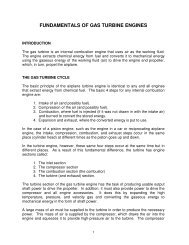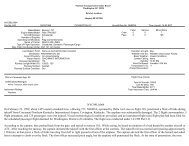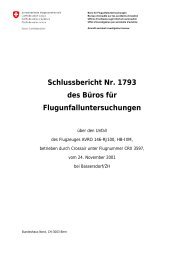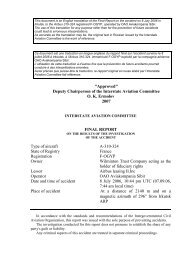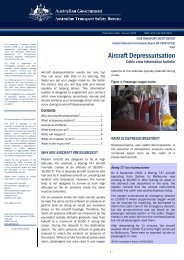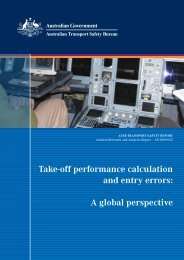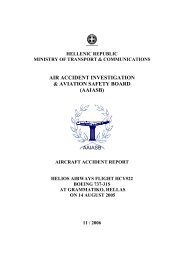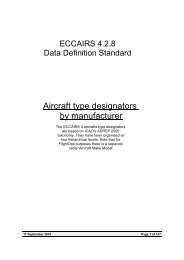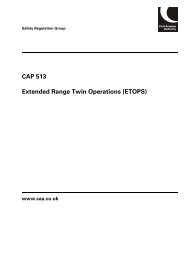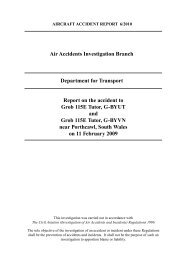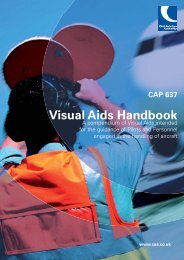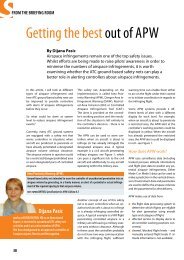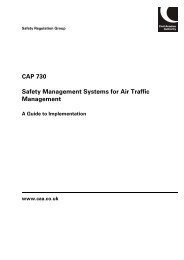CAP 772 - Birdstrike Risk Management for Aerodromes - SKYbrary
CAP 772 - Birdstrike Risk Management for Aerodromes - SKYbrary
CAP 772 - Birdstrike Risk Management for Aerodromes - SKYbrary
You also want an ePaper? Increase the reach of your titles
YUMPU automatically turns print PDFs into web optimized ePapers that Google loves.
<strong>CAP</strong> <strong>772</strong> <strong>Birdstrike</strong> <strong>Risk</strong> <strong>Management</strong> <strong>for</strong> <strong>Aerodromes</strong><br />
Chapter 5 <strong>Birdstrike</strong> Reporting<br />
1 Introduction<br />
1.1 In accordance with Article 143 (Mandatory Reporting of <strong>Birdstrike</strong>s) of the Air<br />
Navigation Order, the commander of an aircraft is required to make a report to the<br />
CAA of any birdstrike occurrence that occurs whilst the aircraft is in flight within<br />
United Kingdom airspace.<br />
1.2 In 2004, the CAA commissioned a study looking into birdstrike reporting <strong>for</strong> the<br />
purpose of assisting the CAA in assessing whether UK birdstrike reporting was as<br />
effective as possible. The results of the study provided an in<strong>for</strong>med basis from which<br />
to develop CAA guidance and policy associated with birdstrike hazard identification<br />
and risk management, in<strong>for</strong>mation sharing and improvements to birdstrike reporting<br />
methods.<br />
2 Definitions<br />
2.1 An industry-wide definition of what constitutes a confirmed, unconfirmed (bird/<br />
wildlife strike) or near-miss occurrence has not previously existed. Many aerodrome<br />
operators have there<strong>for</strong>e established their own set of definitions in order to facilitate<br />
a consistency of reporting and measurement of on-aerodrome birdstrikes, which are<br />
often used to measure key safety per<strong>for</strong>mance indicators, as part of their aerodrome<br />
SMS.<br />
2.2 In order to assist aerodromes, and to aid standardisation and consistency, the CAA,<br />
together with stakeholders, has agreed a set of definitions. These give guidance <strong>for</strong><br />
the determination of confirmed and unconfirmed birdstrike occurrences (shown in<br />
Tables 1 and 2). The definitions shown in Table 1 are based on the best practice<br />
standards produced by the International <strong>Birdstrike</strong> Committee (IBSC) and those<br />
adopted by the International Federation of Airline Pilots Association (IFALPA).<br />
Table 1 <strong>Birdstrike</strong> Definitions – Type of Strike<br />
1 September 2008<br />
A. Confirmed Strike B. Unconfirmed Strike C. Significant Event<br />
Any reported collision<br />
between a bird/wildlife and an<br />
aircraft <strong>for</strong> which evidence in<br />
the <strong>for</strong>m of a carcass, or other<br />
remains are found on the<br />
ground; or damage and/or<br />
other evidence is found on the<br />
aircraft.<br />
Bird/wildlife remains or<br />
complete carcass found on an<br />
aerodrome where there is no<br />
other obvious cause of death<br />
should be treated as a<br />
confirmed strike and reported<br />
as such accordingly.<br />
Any reported collision<br />
between a bird/wildlife and<br />
an aircraft <strong>for</strong> which no<br />
physical evidence is found<br />
(i.e. no damage to the<br />
aircraft is evident upon<br />
inspection, and no bird<br />
remains, carcass or blood<br />
smears are evident on the<br />
airframe).<br />
Incidents where the<br />
presence of birds/wildlife<br />
in the air or on the ground,<br />
resulted in an effect on a<br />
flight but where no<br />
physical evidence of an<br />
actual birdstrike exists.<br />
This includes near-miss<br />
occurrences, rejected<br />
take-off and go-arounds.<br />
Chapter 5 Page 1




